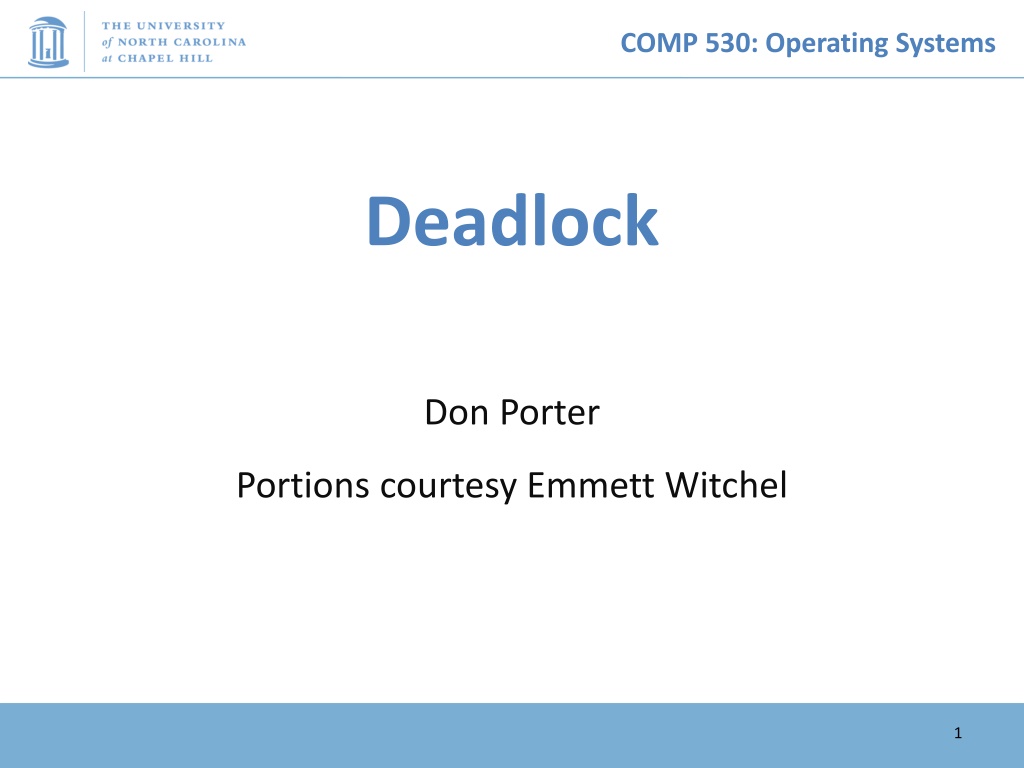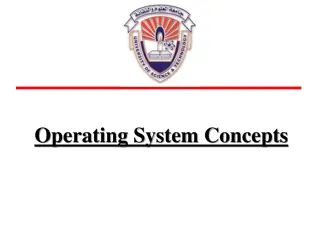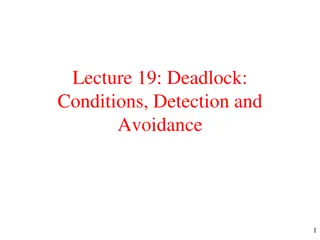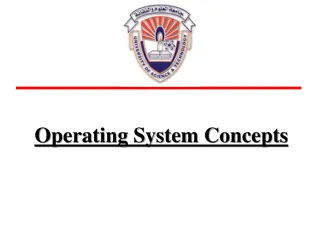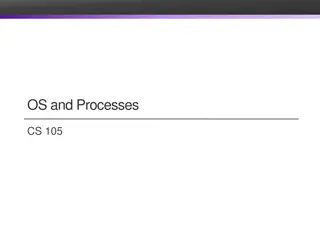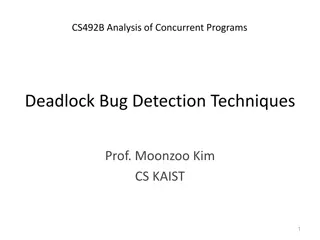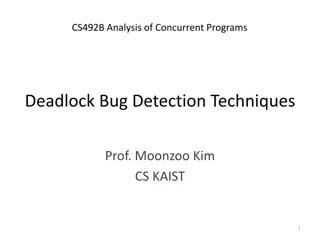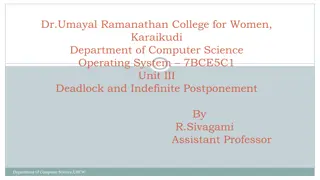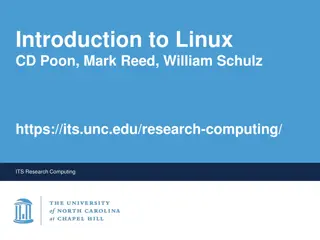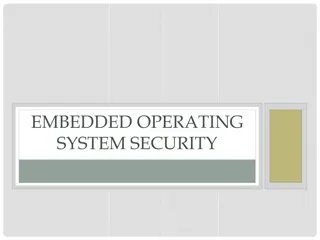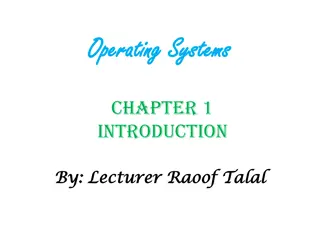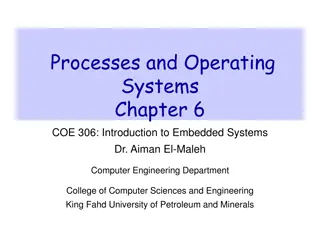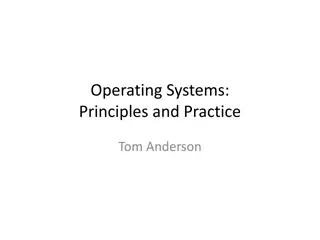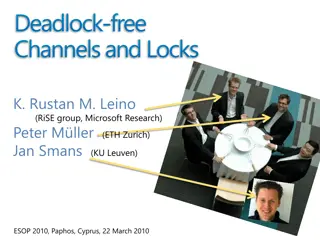Operating Systems Deadlock: Understanding the Concepts
Dive into the world of operating systems deadlock with a focus on defining deadlock, addressing deadlock issues, and exploring motivating examples. Learn about resource allocation graphs and the challenges of coordinating access to shared resources to prevent deadlock scenarios.
Download Presentation

Please find below an Image/Link to download the presentation.
The content on the website is provided AS IS for your information and personal use only. It may not be sold, licensed, or shared on other websites without obtaining consent from the author. Download presentation by click this link. If you encounter any issues during the download, it is possible that the publisher has removed the file from their server.
E N D
Presentation Transcript
COMP 530: Operating Systems Deadlock Don Porter Portions courtesy Emmett Witchel 1
COMP 530: Operating Systems Concurrency Issues Past lectures: Problem: Safely coordinate access to shared resource Solutions: Use locks, condition variables Coordinate access within shared objects What about coordinated access across multiple objects? If you are not careful, it can lead to deadlock Today s lecture: What is deadlock? How can we address deadlock?
COMP 530: Operating Systems Deadlock: Motivating Examples Two producer processes share a buffer but use a different protocol for accessing the buffers Producer2(){ Lock(producerMutexLock) Lock(emptyBuffer) : } Producer1() { Lock(emptyBuffer) Lock(producerMutexLock) : } A postscript interpreter and a visualization program compete for memory frames PS_Interpreter() { request(memory_frames, 10) <process file> request(frame_buffer, 1) <draw file on screen> } Visualize() { request(frame_buffer, 1) <display data> request(memory_frames, 20) <update display> }
COMP 530: Operating Systems Deadlock: Definition Ready Running Head Tail ready queue Waiting Head Tail semaphore/ condition queues A set of threads is deadlocked when every thread in the set is waiting for an event that can only be generated by some thread in the set Starvation vs. deadlock Starvation: threads wait indefinitely (e.g., because some other thread is using a resource) Deadlock: circular waiting for resources Deadlock starvation, but not the other way
COMP 530: Operating Systems Resource Allocation Graph Basic components of any resource allocation problem Processes and resources Model the state of a computer system as a directed graph G = (V, E) V = the set of vertices = {P1, ..., Pn} {R1, ..., Rm} Pi Rj E = the set of edges = {edges from a resource to a process} {edges from a process to a resource} request edge allocation edge Pi Pk Rj
COMP 530: Operating Systems Resource Allocation Graph: Example A PostScript interpreter that is waiting for the frame buffer lock and a visualization process that is waiting for memory V = {PS interpret, visualization} {memory frames, frame buffer lock} Visualization Process Memory Frames PostScript Interpreter Frame Buffer
COMP 530: Operating Systems Resource Allocation Graph & Deadlock Theorem: If a resource allocation graph does not contain a cycle then no processes are deadlocked A cycle in a RAG is a necessary condition for deadlock Is the existence of a cycle a sufficient condition? Game Memory Frames Visualization Process PostScript Interpreter Frame Buffer
COMP 530: Operating Systems Resource Allocation Graph & Deadlock Theorem: If there is only a single unit of all resources then a set of processes are deadlocked iff there is a cycle in the resource allocation graph Memory Frames Visualization Process PostScript Interpreter Frame Buffer
COMP 530: Operating Systems An Operational Definition of Deadlock Visualization Process Memory Frames PostScript Interpreter Frame Buffer A set of processes are deadlocked iff the following conditions hold simultaneously 1. Mutual exclusion is required for resource usage (serially useable) 2. A process is in a hold-and-wait state 3. Preemption of resource usage is not allowed 4. Circular waiting exists (a cycle exists in the RAG)
COMP 530: Operating Systems Deadlock Prevention and/or Recovery Adopt some resource allocation protocol that ensures deadlock can never occur Deadlock prevention/avoidance Guarantee that deadlock will never occur Generally breaks one of the following conditions: Mutex Hold-and-wait No preemption Circular wait *This is usually the weak link* Deadlock detection and recovery Admit the possibility of deadlock occurring and periodically check for it On detecting deadlock, abort Breaks the no-preemption condition And non-trivial to restore all invariants What does the RAG for a lock look like?
COMP 530: Operating Systems Deadlock Avoidance: Resource Ordering Recall this situation. How can we avoid it? Producer2(){ Lock(producerMutexLock) Lock(emptyBuffer) : } Producer1() { Lock(emptyBuffer) Lock(producerMutexLock) : } Eliminate circular waiting by ordering all locks (or semaphores, or resoruces). All code grabs locks in a predefined order. Problems? Maintaining global order is difficult, especially in a large project. Global order can force a client to grab a lock earlier than it would like, tying up a resource for too long. Deadlock is a global property, but lock manipulation is local.
COMP 530: Operating Systems Lock Ordering A program code convention Developers get together, have lunch, plan the order of locks In general, nothing at compile time or run-time prevents you from violating this convention Research topics on making this better: Finding locking bugs Automatically locking things properly Transactional memory 12
COMP 530: Operating Systems How to order? What if I lock each entry in a linked list. What is a sensible ordering? Lock each item in list order What if the list changes order? Uh-oh! This is a hard problem Lock-ordering usually reflects static assumptions about the structure of the data When you can t make these assumptions, ordering gets hard 13
COMP 530: Operating Systems Linux solution In general, locks for dynamic data structures are ordered by kernel virtual address I.e., grab locks in increasing virtual address order A few places where traversal path is used instead 14
COMP 530: Operating Systems Lock ordering in practice From Linux: fs/dcache.c void d_prune_aliases(struct inode *inode) { struct dentry *dentry; struct hlist_node *p; restart: spin_lock(&inode->i_lock); hlist_for_each_entry(dentry, p, &inode->i_dentry, d_alias) { spin_lock(&dentry->d_lock); if (!dentry->d_count) { __dget_dlock(dentry); __d_drop(dentry); spin_unlock(&dentry->d_lock); spin_unlock(&inode->i_lock); dput(dentry); goto restart; } spin_unlock(&dentry->d_lock); } spin_unlock(&inode->i_lock); } Care taken to lock inode before each alias Inode lock protects list; Must restart loop after modification 15
COMP 530: Operating Systems mm/filemap.c lock ordering * Lock ordering: * ->i_mmap_lock (vmtruncate) * ->private_lock (__free_pte->__set_page_dirty_buffers) * ->swap_lock (exclusive_swap_page, others) * ->mapping->tree_lock * ->i_mutex * ->i_mmap_lock (truncate->unmap_mapping_range) * ->mmap_sem * ->i_mmap_lock * ->page_table_lock or pte_lock (various, mainly in memory.c) * ->mapping->tree_lock (arch-dependent flush_dcache_mmap_lock) * ->mmap_sem * ->lock_page (access_process_vm) * ->mmap_sem * ->i_mutex (msync) * ->i_mutex * ->i_alloc_sem (various) * ->inode_lock * ->sb_lock (fs/fs-writeback.c) * ->mapping->tree_lock (__sync_single_inode) * ->i_mmap_lock * ->anon_vma.lock (vma_adjust) * ->anon_vma.lock * ->page_table_lock or pte_lock (anon_vma_prepare and various) * ->page_table_lock or pte_lock * ->swap_lock (try_to_unmap_one) * ->private_lock (try_to_unmap_one) * ->tree_lock (try_to_unmap_one) * ->zone.lru_lock (follow_page->mark_page_accessed) * ->zone.lru_lock (check_pte_range->isolate_lru_page) * ->private_lock (page_remove_rmap->set_page_dirty) * ->tree_lock (page_remove_rmap->set_page_dirty) * ->inode_lock (page_remove_rmap->set_page_dirty) * ->inode_lock (zap_pte_range->set_page_dirty) * ->private_lock (zap_pte_range->__set_page_dirty_buffers) * ->task->proc_lock * ->dcache_lock (proc_pid_lookup) */ /* 16
COMP 530: Operating Systems Deadlock Recovery R1 R2 R3 R4 P5 P1 P2 P3 P4 Abort all deadlocked processes & reclaim their resources Abort one process at a time until all cycles in the RAG are eliminated Where to start? Select low priority process Processes with most allocation of resources Caveat: ensure that system is in consistent state (e.g., transactions) Optimization: Checkpoint processes periodically; rollback processes to checkpointed state Common in Databases; Hard in General-Purpose Apps
COMP 530: Operating Systems Deadlock Avoidance: Banker s Algorithm Examine each resource request and determine whether or not granting the request can lead to deadlock Define a set of vectors and matrices that characterize the current state of all resources and processes resource allocation state matrix Allocij= the number of units of resource j held by process i R1R2R3... Rr n1,1n1,2n1,3... n1,r n2,1 n3,1 np,1 P1 P2 P3 Pp n2,2 maximum claim matrix Maxij= the maximum number of units of resource j that the process i will ever require simultaneously available vector Availj= the number of units of resource j that are unallocated ... ... ... np,r ... <n1, n2, n3, ..., nr>
COMP 530: Operating Systems Dealing with Deadlock What are some problems with the banker s algorithm? Very slow O(n2m) Too slow to run on every allocation. What else can we do? Deadlock prevention and avoidance: Develop and use resource allocation mechanisms and protocols that prohibit deadlock Deadlock detection and recovery: Let the system deadlock and then deal with it Detect that a set of processes are deadlocked Recover from the deadlock
COMP 530: Operating Systems Summary and Editorial Deadlock is one difficult issue with concurrency Lock ordering is most common solution But can be hard: Different traversal paths in a data structure Complicated relationship between structures Requires thinking through the relationships in advance Other solutions possible Detect deadlocks, abort some programs, put things back together (common in databases) Transactional Memory Banker s algorithm 20
COMP 530: Operating Systems Current Reality Fine-Grained Locking Performance Coarse-Grained Locking Complexity Unsavory trade-off between complexity and performance scalability 21
